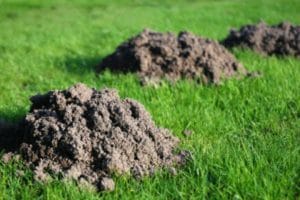When to Apply Grub Control For Your Lawn
Grubs feed on the roots of your grass. An indication you may have a grub infestation problem shows itself in areas of your lawn that have begun to wilt and brown in irregular shapes. Grub Control, like many details in caring for your lawn care, is best left to a lawn service professional. Many times homeowners trying to get rid of white moles, may apply too much or too little insecticide, apply it is areas that may not be affected and apply at the wrong time of year. Being well intentioned, they try to save themselves money, only to find they may have actually wasted them. Contact the lawn care experts at Turf Solutions. We will do a complimentary assessment of your lawn grub situation to determine if control is warranted, how much is needed and when the best time to apply our grub control product in the Lee’s Summit area.
The best defense against lawn grubs, besides a quality grub control product, is a healthy lawn which requires adequate water, fertilizer, and aeration. Contact us and we’ll find out about chemical controls in your area that would have the least impact on your environment.
Removing Lawn Moles
Moles are not rodents, but belong to a group of mammals called insectivores. A mole’s diet is restricted to ground invertebrates such as grubs, millipedes, ants and the like. However, the mole’s primary food source is earthworm, so trying to control white grub and lawn insects is no protection from mole activity. Moles have a very high metabolic rate and, therefore, have to consume large amounts of food. White grubs, earthworms, beetles, and assorted larvae are their principal foods. Moles feed primarily on insects that feed below the ground. Moles do not eat the roots and bulbs of flowers and vegetables, a commonly held belief. Voles and shrews will attack the roots and bulbs. In fact, moles may benefit these plants by feeding on grubs and worms that can damage them. However, the tunneling activities of moles may disfigure lawns and gardens.
grubs, earthworms, beetles, and assorted larvae are their principal foods. Moles feed primarily on insects that feed below the ground. Moles do not eat the roots and bulbs of flowers and vegetables, a commonly held belief. Voles and shrews will attack the roots and bulbs. In fact, moles may benefit these plants by feeding on grubs and worms that can damage them. However, the tunneling activities of moles may disfigure lawns and gardens.
There are a few methods you can choose to remove moles from your lawn. The spring loaded traps that are placed over the runs work well but will require persistence. The other method is the bait that looks and feels like an earthworm that is placed down into the run or tunnel. Both work well but both will require you to locate an active run. An active run is a tunnel they use on a daily bases. To find an active run poke a small quarter-size hole into the mole run and mark it with a stick or flag so you can find it later. Come back in 24 hours. If its repaired you have an active run. If not, go and repeat the process until you find an active run.
Think you have voles? Check out our Lawn Care How To page to read about getting rid of voles.
